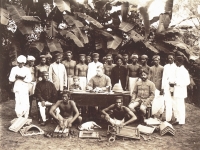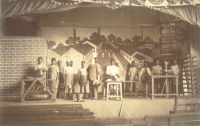54
Veni, Vidi, Vici (I came, I saw, I conquered) 2&3
Media | Terracotta roof tiles, iron, photographs; Mission 21 archives Basel, wall text
Size; 165x925x367cm
( Text from Art Unlimited catalogue)
L.N. Tallur’s installation Veni, Vidi, Vici (I came, I saw, I conquered) is based upon a strange confluence in India’s colonial history. Two hundred years ago, Christian
missionaries from Basel opened a tile factory in the coastal town of Mangalore in the southern Indian state of Karnataka (where L.N. Tallur was raised and con- tinues to live part-time). Their aim was to provide employment for the local Indians whom they had converted to Christianity. After World War II, this tile factory was taken over by the British and named the Commonwealth Tiles Factory. During the same time, in Mumbai, small figurines of Hindu renunciates (called Hatha Yogi) were being fabricated to be used in ethnographic displays in the Victoria & Albert Museum in Mumbai (now renamed the Dr. Bhau Daji Lad Mumbai City Museum), under the guidance of British officers. Hatha Yoga teaches the ability to conquer both the body and the mind through meditation and physical control. What sepa- rates Hatha Yoga from more commonplace yoga practices is the degree of self-discipline it imposes. Practitioners often resort to extreme measures such as standing on one leg or holding up an arm for extended periods of time until
it becomes paralyzed. While drawing a connection between Hatha Yoga, the rep- resentations of colonial subjects for museological displays, and the gruelling experience of the missionaries during their time in India, Tallur's sculpture also reflects upon some of the more absurd manifestations of human endeavor. The complicated exchanges between the legacies of cultural imperialism and the ever-increasing popularity of yoga around the world today attest to an inverse dynamic of colonialism – one potentially mirrored by an Indian artist from Karnataka exhibiting his work in Basel itself.

photowork
















